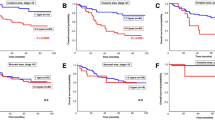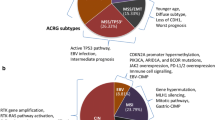Abstract
The limited prognostic value of currently used histologic classifications of gastric cancer and their failure to account for the complexity of the disease as revealed by more recent investigations prompted a combined reinvestigation of histologic, molecular, and clinicopathologic patterns in 294 extensively sampled, invasive gastric cancers representing all main histotypes and stages of the disease and followed for a median of 150 months. Among histologic parameters tested, only cellular atypia, angio-lympho- or neuroinvasion, Ki67 proliferation index, expansile/infiltrative type growth, and T8 cell-rich high lymphoid intra-/peritumor response (HLR) proved to be stage-independent predictors of patient survival. Among molecular tests, p53 gene exon 7 (loop 3) and 8 (loop-sheet-helix motif and S-10 band), but not p53 protein overexpression, TP53 LOH or 18qLOH, were found to worsen prognosis. Microsatellite DNA instability was a favorable prognostic factor when coupled with HLR. Patient survival analysis of the main histotypes and their subtypes confirmed the favorable prognosis of HLR, well-differentiated tubular, muconodular, and low grade diffuse desmoplastic cancers, and highlighted the worse prognosis of anaplastic and infiltrative-lymphoinvasive mucinous cancers compared to ordinary cohesive and diffuse cancers. Distinct roles of individual morphologic and molecular factors in tumor progression of the different histotypes have been recognized. The combination of survival-predictive histotypes and individual histologic or molecular parameters allowed us to develop a classification of all gastric cancers into three grades of increasing malignancy which proved to be of high prognostic value.






Similar content being viewed by others
References
Ribeiro MM, Seixas M, Sobrinho-Simoes M (1988) Prognosis in gastric carcinoma. The preeminence of staging and futility of histological classification. Dig Dis Pathol 1:51–68
Carneiro F, Seixas M, Sobrinho-Simoes M (1995) New elements for an updated classification of the carcinomas of the stomach. Pathol Res Pract 191:571–584
Chiaravalli AM, Cornaggia M, Furlan D et al (2001) The role of histological investigation in prognostic evaluation of advanced gastric cancer. Analysis of histological structure and molecular changes compared with invasive pattern and stage. Virchows Arch 439:158–169
Lauren P (1965) The two histological main types of gastric carcinoma: diffuse and so-called intestinal-type carcinoma. An attempt at a histo-clinical classification. Acta Pathol Microbiol Scand 64:31–49
Esaki Y, Hirayama R, Hirokawa K (1990) A comparison of patterns of metastasis in gastric cancer by histologic type and age. Cancer 65:2086–2090
Uchino S, Noguchi M, Ochiai A, Saito T, Kobayashi M, Hirohashi S (1993) P53 Mutation in gastric cancer: a genetic model for carcinogenesis is common to gastric and colorectal cancer. Int J Cancer 54:759–764
Becker KF, Atkinson MJ, Reich U, Becker I, Nekarda H, Siewert JR, Hofler H (1994) E-cadherin gene mutations provide clues to diffuse type gastric carcinomas. Cancer Res 54:3845–3852
Ranzani GN, Luinetti O, Padovan LS et al (1995) p53 gene mutations and protein nuclear accumulation are early events in intestinal type gastric cancer but late events in diffuse type. Cancer Epidemiol Biomarkers Prev 4:223–231
Solcia E, Fiocca R, Luinetti O et al (1996) Intestinal and diffuse gastric cancers arise in a different background of Helicobacter pylori gastritis through different gene involvement. Am J Surg Pathol 20(Suppl 1):S8–S22
Oliveira C, Seruca R, Seixas M, Sobrinho-Simoes M (1998) The clinicopathological features of gastric carcinomas with microsatellite instability may be mediated by mutations of different “target genes”: a study of the TGFbeta RII, IGFII R, and BAX genes. Am J Pathol 153:1211–1219
Yamamoto H, Perez-Piteira J, Yoshida T et al (1999) Gastric cancers of the microsatellite mutator phenotype display characteristic genetic and clinical features. Gastroenterology 116:1348–1357
Candusso ME, Luinetti O, Villani L et al (2002) Loss of heterozygosity at 18q21 region in gastric cancer involves a number of cancer-related genes and correlates with stage and histology, but lacks independent prognostic value. J Pathol 197:44–50
Stemmermann GN, Brown C (1974) A survival study of intestinal and diffuse types of gastric carcinoma. Cancer 33:1190–1195
Ming SC (1977) Gastric carcinoma. A pathobiological classification. Cancer 39:2475–2485
Kubo T (1971) Histologic appearance of gastric carcinoma in high and low mortality countries: comparison between Kyushu, Japan and Minnesota, USA. Cancer 28:726–734
Watanabe H, Jass JR and Sobin LH in collaboration with pathologists in eight countries (1990) Histological typing of oesophageal and gastric tumors, 2nd ed. Edited by the World Health Organization (WHO). Springer, Berlin, pp. 20–26
Goseki N, Takizawa T, Koike M (1992) Differences in the mode of the extension of gastric cancer classified by histological type: new histological classification of gastric carcinoma. Gut 33:606–612
Martin IG, Dixon MF, Sue-Ling H, Axon AT, Johnston D (1994) Goseki histological grading of gastric cancer is an important predictor of outcome. Gut 35:758–763
Songun I, van de Velde CJ, Arends JW et al (1999) Classification of gastric carcinoma using the Goseki system provides prognostic information additional to TNM staging. Cancer 85:2114–2118
Gabbert HE, Meier S, Gerharz CD, Hommel G (1991) Incidence and prognostic significance of vascular invasion in 529 gastric-cancer patients. Int J Cancer 49:203–207
Watanabe H, Enjoji M, Imai T (1976) Gastric carcinoma with lymphoid stroma. Its morphologic characteristics and prognostic correlations. Cancer 38:232–243
Minamoto T, Mai M, Watanabe K et al (1990) Medullary carcinoma with lymphocytic infiltration of the stomach. Clinicopathologic study of 27 cases and immunohistochemical analysis of the subpopulations of infiltrating lymphocytes in the tumor. Cancer 66:945–952
Grogg KL, Lohse CM, Pankratz VS, Halling KC, Smyrk TC (2003) Lymphocyte-rich gastric cancer: associations with Epstein–Barr virus, microsatellite instability, histology, and survival. Mod Pathol 16:641–651
Chiaravalli AM, Feltri M, Bertolini V et al (2006) Intratumour T cells, their activation status and survival in gastric carcinomas characterised for microsatellite instability and Epstein–Barr virus infection. Virchows Arch 448:344–353
Nakamura S, Ueki T, Yao T, Ueyama T, Tsuneyoshi M (1994) Epstein–Barr virus in gastric carcinoma with lymphoid stroma. Special reference to its detection by the polymerase chain reaction and in situ hybridization in 99 tumors, including a morphologic analysis. Cancer 73:2239–2249
Shiao YH, Palli D, Caporaso NE et al (2000) Genetic and immunohistochemical analyses of p53 independently predict regional metastasis of gastric cancers. Cancer Epidemiol Biomarkers Prev 9:631–633
Inoue H, Matsuyama A, Mimori K, Ueo H, Mori M (2002) Prognostic score of gastric cancer determined by cDNA microarray. Clin Cancer Res 8:3475–3479
Xiangming C, Natsugoe S, Takao S et al (2001) Preserved Smad4 expression in the transforming growth factor beta signaling pathway is a favorable prognostic factor in patients with advanced gastric cancer. Clin Cancer Res 7:277–282
Kim YH, Lee HS, Lee HJ et al (2004) Prognostic significance of the expression of Smad4 and Smad7 in human gastric carcinomas. Ann Oncol 15:574–580
Yonemura Y, Ninomiya I, Ohoyama S et al (1991) Expression of c-erbB-2 oncoprotein in gastric carcinoma. Immunoreactivity for c-erbB-2 protein is an independent indicator of poor short-term prognosis in patients with gastric carcinoma. Cancer 67:2914–2918
Weiss MM, Kuipers EJ, Postma C et al (2004) Genomic alterations in primary gastric adenocarcinomas correlate with clinicopathological characteristics and survival. Cell Oncol 26:307–317
Endoh Y, Tamura G, Motoyama T, Ajioka Y, Watanabe H (1999) Well-differentiated adenocarcinoma mimicking complete-type intestinal metaplasia in the stomach. Hum Pathol 30:826–832
Solcia E, Luinetti O, Tava F et al (2004) Identification of a lower grade muconodular subtype of gastric mucinous cancer. Virchows Arch 445:572–579
Chiaravalli AM, Klersy C, Tava F et al (2009) Lower and higher grade subtypes of diffuse gastric cancer. Human Pathol (in press). doi:10.1016/j.humpath.2009.04.004
Matsui K, Kitagawa M, Miwa A, Kuroda Y, Tsuji M (1991) Small cell carcinoma of the stomach: a clinicopathologic study of 17 cases. Am J Gastroenterol 86:1167–1175
Rindi G, Azzoni C, La Rosa S et al (1999) ECL cell tumor and poorly differentiated endocrine carcinoma of the stomach: prognostic evaluation by pathological analysis. Gastroenterology 116:532–542
Jiang SX, Mikami T, Umezawa A, Saegusa M, Kameya T, Okayasu I (2006) Gastric large cell neuroendocrine carcinomas: a distinct clinicopathologic entity. Am J Surg Pathol 30:945–953
Krulewski T, Cohen LB (1988) Choriocarcinoma of the stomach: pathogenesis and clinical characteristics. Am J Gastroenterol 83:1172–1175
Nagai E, Ueyama T, Yao T, Tsuneyoshi M (1993) Hepatoid adenocarcinoma of the stomach. A clinicopathologic and immunohistochemical analysis. Cancer 72:1827–1835
Sobin LH, Wittekind C (1997) TNM classification of malignant tumors, 5th edn. Wiley-Liss, New York, pp 59–62
Boland CR, Thibodeau SN, Hamilton SR et al (1998) A national cancer institute workshop on microsatellite instability for cancer detection and familial predisposition: development of international criteria for the determination of microsatellite instability in colorectal cancer. Cancer Res 58:5248–5257
Vogelstein B, Fearon ER, Hamilton SR et al (1988) Genetic alterations during colorectal tumor development. N Engl J Med 319:525–532
Elston CW, Ellis IO (1991) Pathological prognostic factors in breast cancer. I. The value of histological grade in breast cancer: experience from a large study with long-term follow-up. Histopathology 19:403–410
Stalsberg H, Hartmann WH (2000) The delimitation of tubular carcinoma of the breast. Hum Pathol 31:601–607
Huang C, Taki T, Adachi M, Konishi T, Higashiyama M, Miyake M (1998) Mutations in exon 7 and 8 of p53 as poor prognostic factors in patients with non-small cell lung cancer. Oncogene 16:2469–2477
Skaug V, Ryberg D, Kure EH et al (2000) P53 Mutations in defined structural and functional domains are related to poor clinical outcome in non-small cell lung cancer patients. Clin Cancer Res 6:1031–1037
Erber R, Conradt C, Homann N et al (1998) TP53 DNA contact mutations are selectively associated with allelic loss and have a strong clinical impact in head and neck cancer. Oncogene 16:1671–1679
Borresen-Dale AL, Lothe RA, Meling GI, Hainaut P, Rognum TO, Skovlund E (1998) TP53 and long-term prognosis in colorectal cancer: mutations in the L3 zinc-binding domain predict poor survival. Clin Cancer Res 4:203–210
Cho Y, Gorina S, Jeffrey PD, Pavletich NP (1994) Crystal structure of a p53 tumor suppressor–DNA complex: understanding tumorigenic mutations. Science 265:346–355
Guidoboni M, Gafa R, Viel A et al (2001) Microsatellite instability and high content of activated cytotoxic lymphocytes identify colon cancer patients with a favorable prognosis. Am J Pathol 159:297–304
dos Santos NR, Seruca R, Constancia M, Seixas M, Sobrinho-Simoes M (1996) Microsatellite instability at multiple loci in gastric carcinoma: clinicopathologic implications and prognosis. Gastroenterology 110:38–44
Saiki Y, Ohtani H, Naito Y, Miyazawa M, Nagura H (1996) Immunophenotypic characterization of Epstein–Barr virus-associated gastric carcinoma: massive infiltration by proliferating CD8+ T-lymphocytes. Lab Invest 75:67–76
van Beek J, zur Hausen A, Snel SN et al (2006) Morphological evidence of an activated cytotoxic T-cell infiltrate in EBV-positive gastric carcinoma preventing lymph node metastases. Am J Surg Pathol 30:59–65
Ciernik IF, Berzofsky JA, Carbone DP (1996) Human lung cancer cells endogenously expressing mutant p53 process and present the mutant epitope and are lysed by mutant-specific cytotoxic T lymphocytes. Clin Cancer Res 2:877–882
Vierboom MP, Nijman HW, Offringa R et al (1997) Tumor eradication by wild-type p53-specific cytotoxic T lymphocytes. J Exp Med 186:695–704
Koriyama C, Akiba S, Itoh T et al (2002) Prognostic significance of Epstein–Barr virus involvement in gastric carcinoma in Japan. Int J Mol Med 10:635–639
Adachi Y, Mori M, Kido A, Shimono R, Maehara Y, Sugimachi K (1992) A clinicopathologic study of mucinous gastric carcinoma. Cancer 69:866–871
Wu CY, Yeh HZ, Shih RT, Chen GH (1998) A clinicopathologic study of mucinous gastric carcinoma including multivariate analysis. Cancer 83:1312–1318
Park JM, Jang YJ, Kim JH et al (2008) Gastric cancer histology: clinicopathologic characteristics and prognostic value. J Surg Oncol 98:520–525
Acknowledgements
This investigation was supported by grants from the Italian Ministry of Health (RF-PSM-2006-401346) and the Fondazione IRCCS Policlinico San Matteo to ES.
We declare that we have no conflict of interest.
Author information
Authors and Affiliations
Corresponding author
Rights and permissions
About this article
Cite this article
Solcia, E., Klersy, C., Mastracci, L. et al. A combined histologic and molecular approach identifies three groups of gastric cancer with different prognosis. Virchows Arch 455, 197–211 (2009). https://doi.org/10.1007/s00428-009-0813-z
Received:
Revised:
Accepted:
Published:
Issue Date:
DOI: https://doi.org/10.1007/s00428-009-0813-z




